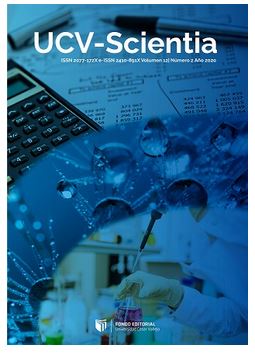Importance of science, technology and innovation in economic growth: a comparison between Latin America and the so-called asian tigers
DOI:
https://doi.org/10.18050/revucv-scientia.v12i1.1012Keywords:
Science, Technology, Innovation, Economic Growth, Pacific AllianceAbstract
The paper aims to describe the importance of the science, technology and innovation sector in economic growth through the study of countries belonging to the Pacific Alliance (AP), the Asian Tigers and China. Methodologically, a descriptive statistics analysis (or exploratory data analysis) is performed, which presents a comparative analysis of the growth trend in production variables such as GDP and GDP per capita between 1970 and 2016, also it show sector indicators like the participation of investment resources in research and development, as well as the number of patents registered by residents. Among the main findings is that Asian economies have grown faster than Latin American economies, a result that has led them to higher levels of GDP per capita. Moreover it concluded that the asiatic countries have been a model of economic success among developing economies largely explained by: (i) the innovations and technological advances that enabled it to consolidate into the global market, and (ii) economic integration increasingly strong with a product and/or service offering with higher technological content
References
Atkinson, A. (2015). Desigualdad ¿Qué podemos hacer? Ciudad de México: Fondo de Cultura Económica.
BID. (2000). La ciencia y la tecnología para el desarrollo. Una estrategia del BID. Washington D.C.: Banco Interamericano de Desarrollo. Serie de informes de políticas y estrategias sectoriales del Departamento de Desarrollo Sostenible.
BID. (2005). ¿Cómo puede América Latina ponerse al día? Banco Interamericano de Desarrollo. Revista BID América.
Cantwell, J. (1989). TechnologicalInnovation and MultinationalCorporations. Oxford: Blackwell.
Casson, M. (1995). TheOrganizationof International Business. Aldershot: Edward Elgar.
Cheng, L. (2012). TheBrics in the global valuechains: anempirical notes. Revista Cuadernos de Economía 31 (57), Nro Especial.
Dahlman, C. (2007). Technology, globalization and international competitiveness: ChallengesfordevelopingCountries”, Industrial developmentforthe 21st century, Departmentofeconomic and social affairsofUnitedNations.
Domar, E.D. (1946). Capital expansion, rateofgrowth, and employment.Econometrica, nro. 14, pp. 137-147
Elson, A. (2006). ¿Qué sucedió? Finanzas y Desarrollo, Fondo Monetario Internacional , 37-40.
Grossman, G.M. y Helpman, E. (1991).Innovation and growth in the global economy. MIT Press, Cambridge, MA
Harrod, R. (1948). Towards a Dynamic Economics, London, Macmillan
Held, D., McGrew, A., Goldblatt, D., &Perraton, J. (2002). Transformaciones Globales. Política, economía y cultura. México D. F.: Oxford UniversityPress
Noland, M. (1997). Has Asianexport performance beenunique?Journalof International Economics , 1-2.
Rodrik, D., Subramanian, A., &Trebbi, F. (2002). Institution Rule: ThePrimacyofInstitutionsoverIntegration and Geography in EconomicDevelopment. IMF WorkingPaper, International MonetaryFund
Rodrik, D. (2011). La paradoja de la globalización. Editorial Antoni Bosch.
Romer,P.(1986). Increasingreturnsandlong-rungrowth. JournalofPoliticalEconomy, 94, pp. 1002-1037.
Romer, P. (1990). Endogenoustechnologicalchange.JournalofPoliticalEconomy, vol. 98 m, pp. 71-102.
Sachs, J.& Andrew W. (1995).EconomicReform and theProcessof Global Integration. Brookings PapersonEconomicActivity, 1995:1, 1-118.
Schumpeter, J. (1911). Teoría del desarrollo económico. Fondo de Cultura Económica, México, 5ta Edición, 1978.
Schumpeter, J. (1942). Capitalismo, socialismo y democracia. Editorial Aguilar, Madrid, 1968.
Swan, T.W. (1956).Economicgrowth and capital accumulation.EconomicRecord, 32, pp. 334-361
Solow,R.(1956). AContributiontotheTheoryofEconomicGrowth. QuarterlyJournalofEconomics,Vol. 70, No. 1, pp. 65-94
Solow,R.(1957). Technicalchangeandtheaggregateproductionfunction. ReviewofEconomics and Statistics, 39, pp. 312-320.
Downloads
Published
How to Cite
Issue
Section
License
Copyright (c) 2020 UCV-Scientia

This work is licensed under a Creative Commons Attribution-NonCommercial 4.0 International License.
- Share — copy and redistribute the material in any medium or format
- Adapt — remix, transform, and build upon the material.
- The licensor cannot revoke these freedoms as long as you follow the license terms.
Under the following terms:
-
Attribution — You must give appropriate credit, provide a link to the license, and indicate if changes were made. You may do so in any reasonable manner, but not in any way that suggests the licensor endorses you or your use.
- No additional restrictions — You may not apply legal terms or technological measures that legally restrict others from doing anything the license permits.













